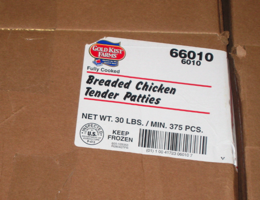"Sorry I'm late," Nicole Barron, Food Services Accounting and Business Services Manager for Minneapolis Public Schools tells me. "There was a baby food recall, and I had to run over to Target to see what they had left and make sure it got over to the schools."
"Baby food?" I ask jokingly, cluelessly. "Is that for my kids?"
"I don't think so," Nicole answers, "it's for high school kids who have babies and need to feed them during the day."
The depths of my lack of understanding are only starting to become clear. Students with babies? We're just barely scratching the surface.
"Your kids' school is diverse," Irfan Chaudhry tells me, "but on the north side of the city, it's a completely different story. The food they eat at school may be the only food these kids get." This is a refrain I hear over and over again as I try to make sense of the options our kids are given in their schools. "We look at daily participation," Irfan continues,"we have to serve product our kids will eat."
About 2/3 of all children attending Minneapolis Public Schools are eligible for free or reduced price lunch. According to Irfan, for a sizable percentage of these kids, the food they eat at school is the only food they eat.
National government programs reimburse Minneapolis Public Schools a certain amount of money for each school lunch consumed. Here's how the reimbursements break down:
- $2.80 for each free lunch
- $2.40 for each reduced price lunch
- $0.40 for each paid lunch
Students who buy their own lunch in Minneapolis Public Schools pay $1.75. A little bit of quick math ($1.75 paid lunch plus $0.40 subsidy) shows that the students who buy their own lunch actually cost the district $0.65. Or, as Nicole puts it, "the free eligible students subsidize the paying students."
And how much of this paltry sum pays for the food itself?
According to Nicole, the numbers typically break down like this:
- 40% of the money is spent on food
- 40% is spent on labor
- 20% is spent on other expenses, including electricity, supplies, and transportation
That means that, for students who get a free lunch, the district can spend approximately $1.12 on the food itself. For students who buy their lunch, the number goes down to $0.86.
 Boxes of breaded chicken patties, no longer welcome in Minneapolis Public Schools, still line the walls of the distribution center While Minneapolis Public Schools haven't had much luck getting more money from the feds, they've been very successful in reallocating how the dollars are spent. Specifically, the Food Services team has created multiple efficiencies that have helped them to reduce labor costs; the money they save on labor allows them to spend more on food. Last year, food made up more than 42% of the budget. This year, the percentage will be even higher.
Boxes of breaded chicken patties, no longer welcome in Minneapolis Public Schools, still line the walls of the distribution center While Minneapolis Public Schools haven't had much luck getting more money from the feds, they've been very successful in reallocating how the dollars are spent. Specifically, the Food Services team has created multiple efficiencies that have helped them to reduce labor costs; the money they save on labor allows them to spend more on food. Last year, food made up more than 42% of the budget. This year, the percentage will be even higher.
When there's money, it's spent quickly. When the school district replaced breaded chicken patties with whole muscle, non-breaded chicken breast fillets last year, the cost went from $0.30 to $0.58 per unit. Because the district runs its food service program like a separate, self-sustaining business, these $0.28 have to come from some place. Other foods, labor efficiencies, additional funding, the profits of providers -- it's all on the table.
A Game of Numbers
While the amount of money the district has to spend on each meal is minuscule, the number of meals the district provides is staggering. This year, Minneapolis Public Schools will provide:
- More than 12,000 breakfasts per day, or 2,064,000+ per year (there are 172 school days)
- More than 21,000 lunches per day, or 3,612,000+ per year
- 5,000 snacks per day, or 860,000+ per year
- 300,000+ meals during the summer
In total, Minneapolis Public Schools provides nearly 7 million meals and snacks to our kids each year. They do this with a staff of approximately 150 workers, and within a budget of less than $2.80 per student, including food, transportation, fuel, real estate, and labor combined.
If you've ever wondered why school lunch isn't better than it is, maybe this will make you wonder why it isn't much, much worse.
Please read these related articles:
- Getting to Know the Minneapolis Public Schools Food Service Department, Part Two: Small Changes, Big Improvements
- Getting to Know the Minneapolis Public Schools Food Service Department, Part Three: The Unsung Heroes

Lee Zukor is the founder of Simple, Good, and Tasty. E-mail him at lee@simplegoodandtasty.com or follow him on Twitter.




